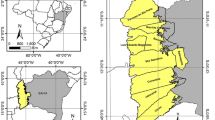Abstract
The present study aims to identify the wastelands distribution, fragmentation pattern, and their clusters between 1991 and 2019 in the Korba district of Chhattisgarh. Multi-temporal Landsat satellite data were used to recognize the different classes of wastelands. The landscape fragmentation analysis of wasteland categories was performed through FRAGSTATS v.4.2 in patch analyst. Moran’s I and Getis–Ord (Gi*) statistics were used to identify wasteland clusters and outlier analyses. Most of the wastelands were distributed in the east and north of the district, and there was a decreasing trend observed during the study period. Hotspot and outlier analysis demonstrate the existence of homogeneous and heterogeneous wasteland groups based on their spatial proximity and fragmentation pattern. The present research using satellite-based analysis of wasteland fragments could play a major role in verbalizing strategies for safeguarding native forest areas and degraded wasteland in the Korba district.







Similar content being viewed by others
References
Basnyat, B. (2009). Impacts of demographic changes on forests and forestry in Asia and the Pacific. Asia-Pacific Forestry Sector Outlook Study II. Working paper no. APFSOS II/WP/2009/08. http://www.fao.org/3/a-am253e.pdf.
Bera, S., & Chatterjee, N. D. (2019). Mapping and monitoring of land use dynamics with their change hotspot in North 24-Parganas district, India: A geospatial-and statistical-based approach. Modeling Earth Systems and Environment. https://doi.org/10.1007/s40808-019-00601-2
Chandramohan, T., & Durbude, D. G. (2002). Estimation of soil erosion potential using universal soil loss equation. Journal of the Indian Society of Remote Sensing, 30(4), 181–190.
Contador, J. F. L., Schnabel, S., Gómez Gutiérrez, A., & Fernández, M. P. (2008). Mapping sensitivity to land degradation in Extremadura, SW Spain. Boletín de la Asociación de Geógrafos Españoles, 53, 387–390.
Fotheringham, A. S. (2009). The problem of spatial autocorrelation” and local spatial statistics. Geographical Analysis, 41, 398–403.
Grunwald, S. (2013). The current state of digital soil mapping and what is next. In J. L. Boetinger, D. W. Howell, A. C. Moore, A. E. Hartemink, & S. Kienst-Brown (Eds.), Digital soil mapping: Bridging research, production and environmental applications (pp. 3–12). Springer.
Jain, A. K., Hooda, R. S., Nath, J., & Manchanda, M. L. (1991). Mapping and monitoring of urban landuse of Hisar Town, Haryana using remote sensing techniques. Journal of the Indian Society of Remote Sensing, 19(2), 125–134.
Joshi, P. K., Kumar, M., Midha, N., Yanand, V., & Paliwal, A. (2006). Assessing areas deforested by coal mining activities through satellite remote sensing images and GIS in parts of Korba, Chhattisgarh. Journal of the Indian Society of Remote Sensing, 34(4), 415–421.
Long, J., & Robertson, C. (2017). Comparing spatial patterns. Geography Compass, 12, 27–41.
Midha, N., & Mathur, P. K. (2010). Assessment of forest fragmentation in the conservation priority Dudhwa landscape, India using FRAGSTATS computed class level metrics. Journal of the Indian Society of Remote Sensing (September 2010: Special Issue on Biodiversity and Landscape Ecology), 38, 487–500.
MSME-Development Institute, Raipur (Ministry of MSME, Govt. of India). (2016). Brief Industrial Profile of Korba District. http://dcmsme.gov.in/dips/2016-17/Korba.pdf.
Mulder V. L., de Bruin S., Schaepman M. E., Mayrc T. R. (2011). The use of remote sensing in soil and terrain mapping — a review. Geoderma, 162 (1–2), 1–19. https://doi.org/10.1016/j.geoderma.2010.12.018
National Remote Sensing Centre (NRSC). (2019). Wastelands Atlas of India. Change analysis based on temporal satellite data of 2008–2009 and 2015–2016. https://dolr.gov.in/sites/default/files/Wastelands%20Atlas%20-%20Cover%2C%20-Preface%2C%20Contents%2C%20Project%20Team%2C%20Executive%20Summary%2C%20Introduction%20-%20Result.pdf.
Puyravaud, J. P. (2003). Standardizing the calculation of the annual rate of deforestation. Forest Ecology Management, 177, 593–596.
Ramachandra, T. V. (2007). Comparative assessment of techniques for bio-resource monitoring using GIS and remote sensing. The ICFAI Journal of Environmental Sciences, 1(2), 2–8.
Rawat, K. S., Mishra, S. V., & Singh, S. K. (2018). Integration of earth observation data and spatial approach to delineate and manage aeolian sand-affected wasteland in highly productive lands of Haryana, India. International Journal of Geophysics, 7, 5. https://doi.org/10.1155/2018/2847504
Roy, A., & Inamdar, A. B. (2019). Multi-temporal Land Use Land Cover (LULC) change analysis of a dry semi-arid river basin in western India following a robust multi-sensor satellite image calibration strategy. Heliyon, 5(4), e01478.
Roy, D. P., Wulder, M. A., Loveland, T. R., Woodcock, C. E., Allen, R. G., Anderson, M. C., et al. (2014). Landsat-8: Science and product vision for terrestrial global change research. Remote Sensing of Environment, 145, 154–172. https://doi.org/10.1016/j.rse.2014.02.001
Sánchez Martín, J. M., Sánchez Rivero, M., & Rengifo Gallego, J. I. (2013). La evaluación del potencial turístico para el desarrollo del turismo rural. Aplicación metodológica sobre la provincia de Cáceres. Geofocus. Revista Internacional de Ciencia y Tecnología de la Información Geográfica, 13, 99–130.
Trivedi, T. P. (2010). Degraded and wastelands of India status and spatial distribution. Directorate of Information and Publications of Agriculture, Indian Council of Agricultural Research, Krishi Anusandhan Bhavan I, Pusa, New Delhi. https://icar.org.in/files/Degraded-and-Wastelands.pdf.
Uddin, K., Chaudhary, S., Chettri, N., Kotru, R., Murthy, M., Prasad, R., Ning, W., Man, S., & Krishna, S. (2015). The changing land cover and fragmenting forest on the Roof of the World: A case study in Nepal’s Kailash Sacred Landscape. Landscape and Urban Planning, 141, 1–10.
Vogt, P., Riitters, K. H., Estreguil, C., Kozak, J., Wade, T. G., & Wickham, J. D. (2007). Mapping spatial patterns with morphological image processing. Landscape Ecology, 22, 171–177.
Wasteland Atlas of India. (2019). Chhattisgarh, wastelands changes 2008–09–2015–16. https://dolr.gov.in/sites/default/files/Chhattisgarh_0.pdf.
Acknowledgements
Thanks to USGS Earth explorer Community for freely providing satellite data.
Author information
Authors and Affiliations
Corresponding author
Ethics declarations
Conflict of interest
The authors declared that they have no conflict of interest.
Additional information
Publisher's Note
Springer Nature remains neutral with regard to jurisdictional claims in published maps and institutional affiliations.
About this article
Cite this article
Wang, J., Bhunia, G.S. & Shit, P.K. Wasteland Characterization and Fragmentation Analysis in Korba District (Chhattisgarh, India): A Study-Based Geospatial Data and Spatial Statistical Approach. J Indian Soc Remote Sens 50, 701–714 (2022). https://doi.org/10.1007/s12524-021-01490-8
Received:
Accepted:
Published:
Issue Date:
DOI: https://doi.org/10.1007/s12524-021-01490-8




